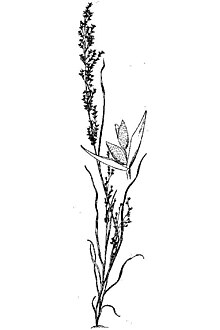
The Channel Islands are an eight-island archipelago located within the Southern California Bight in the Pacific Ocean, off the coast of California. The four Northern Channel Islands are part of the Transverse Ranges geologic province, and the four Southern Channel Islands are part of the Peninsular Ranges province. Five of the islands are within the Channel Islands National Park, and the waters surrounding these islands make up Channel Islands National Marine Sanctuary. The islands were first colonized as early as 13,000 years ago, the earliest paleontological evidence of humans in North America. They are the easternmost islands in the Pacific Island group.

Dissanthelium californicum is a rare species of grass. It was originally discovered on Santa Catalina, an island off California's coast in 1847 by U.S. botanist and naturalist William Gambel. It was later identified as growing on Guadalupe Island, on San Clemente Island and Catalina Island.
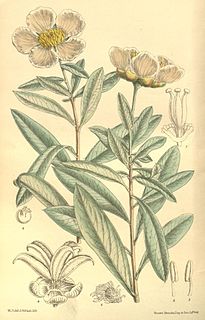
Crossosoma is a genus of the plant family Crossosomataceae. It consists of two species of shrubs.

Bothriochloa is a common and widespread genus of plants in the grass family native to many countries on all inhabited continents and many islands. They are often called beardgrass, bluegrass or bluestem.
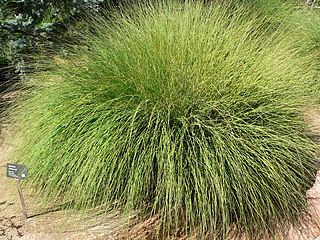
Muhlenbergia is a genus of plants in the grass family.

Axonopus is a genus of plants in the grass family, known generally as carpet grass. They are native primarily to the tropical and subtropical regions of the Americas with one species in tropical Africa and another on Easter Island. They are sometimes rhizomatous and many are tolerant of periodic submersion.
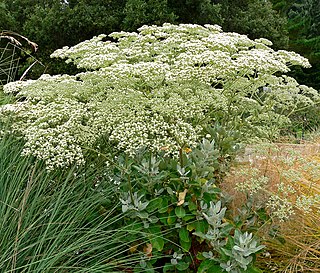
Eriogonum giganteum, with the common name St. Catherine's lace, is a species of wild buckwheat in Southern California.
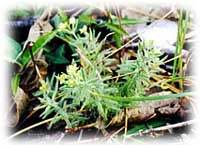
Galium californicum is a species of flowering plant in the coffee family known by the common name California bedstraw.

Dendromecon harfordii, known by the common names Channel Islands tree poppy and Harford's tree poppy, is a species of flowering plant in the poppy family.

Crossosoma californicum, known by the common name California rockflower, is one of only a few species in the flowering plant family Crossosomataceae.

Galium catalinense is a species of flowering plant in the coffee family known by the common name Santa Catalina Island bedstraw. It is endemic to two of the Channel Islands of California, where it grows along the coastal bluffs. It is a shrub growing erect to about a meter in maximum height with a rigid stem lined with whorls of four leaves each. The hairy leaves are generally lance-shaped and one to 2.5 centimeters long. The inflorescence emerging from leaf axils is a dense cluster of whitish flowers.
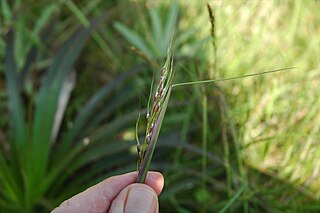
Piptochaetium, or speargrass, is a genus of New World plants in the grass family, native to North and South America. Piptochaetium is a bunchgrass genus in the tribe Stipeae.
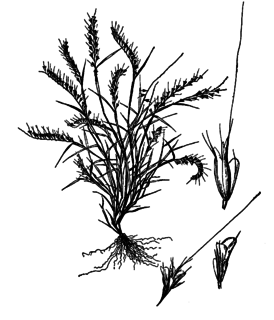
Aegopogon is a genus of New World plants in the grass family.
Luziola (watergrass) is a genus of New World in the grass family, native to North and South America including the West Indies.

Amphibromus is a genus of grasses in the family Poaceae. Most are known as swamp wallaby grass. Most are endemic to Australia. One can also be found in New Zealand and there are two species in South America.

Lyonothamnus is a monotypic genus of trees in the rose family containing the single living species Lyonothamnus floribundus, which is known by the common name Catalina ironwood, and the subspecies L. f. ssp. aspleniifolius and L. f. ssp. floribundus.
Gouinia is a genus of Latin American plants in the grass family.

Poa secunda is a widespread species of perennial bunchgrass native to North and South America. It is highly resistant to drought conditions, and provides excellent fodder; and has also been used in controlling soil erosion, and as revegetator, often after forest fires. Cultivars include 'Canbar', 'Service', 'Sherman', and 'Supernova'. Historically, indigenous Americans, such as the Gosiute of Utah, have used P. secunda for food. It was originally described botanically in 1830 by Jan Svatopluk Presl, from a holotype collected from Chile by Thaddäus Haenke in 1790.
Platanthera cooperi is an uncommon species of orchid known by the common names Cooper's rein orchid and chaparral rein orchid.
The wildlife of the Channel Islands of California is wide and diverse, including many endemic species. While the land wildlife is slightly limited, there being only one large, naturally predatory, and native mammal, the small island fox, marine life can include anything from kelp forests to great white sharks.
